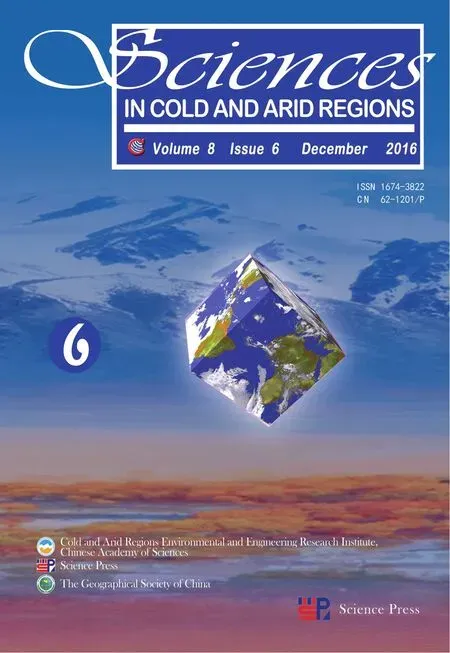Revisit of event-based rainfall characteristics at Shapotou area in northern China
2016-12-19XinPingWangYaFengZhangRuiHuYanXiaPanHaoJieXuWeiShiYanXiaJinHiroshiYasuda
XinPing Wang,YaFeng Zhang,Rui Hu,YanXia Pan,HaoJie Xu,Wei Shi,YanXia Jin,Hiroshi Yasuda
1.Shapotou Desert Research and Experiment Station,Northwest Institute of Eco-Environment and Resources,Chinese Academy of Sciences,Lanzhou,Gansu 730000,China
2.Arid Land Research Center,Tottori University,1390 Hamasaka Tottori,680-0001 Japan
Revisit of event-based rainfall characteristics at Shapotou area in northern China
XinPing Wang1*,YaFeng Zhang1,Rui Hu1,YanXia Pan1,HaoJie Xu1,Wei Shi1,YanXia Jin1,Hiroshi Yasuda2
1.Shapotou Desert Research and Experiment Station,Northwest Institute of Eco-Environment and Resources,Chinese Academy of Sciences,Lanzhou,Gansu 730000,China
2.Arid Land Research Center,Tottori University,1390 Hamasaka Tottori,680-0001 Japan
Distribution of rainfall event sizes and interval lengths between events are important characteristics of arid and semi-arid climates.Understanding their importance will contribute to our ability to understand ecosystem dynamics in these regions.Rainfall event timing and magnitude are important drivers of ecosystem processes and are instrumental in creating landscape heterogeneity in arid and semi-arid regions.Rainfall event characteristics were analyzed using an automatic tipping-bucket rain-gauge record across the entire summer monsoon season from 2008 to 2015 at the arid desert area of Shapotou in the Tengger Desert,China.Changing the minimum inter-event time (MIT) from 30 min to 24 h alters the number of rainfall events from 64 to 25 for the event depth larger than 0.1 mm.The mean rainfall intensity declined from 0.95 mm/h to 0.53 mm/h,and the geometric mean event duration rose from 0.55 h to 4.4 h.The number of rainfall events,mean rainfall intensity,and geometric mean event duration differed under different criteria of individual rainfall depths,except that for an individual rainfall depth of 0.5,1.0,and 5.0 mm.The aforementioned features differed only at the lowest range of the mean rainfall intensity and depth for MIT=3 and 6 h.These findings suggest that identification of event-based rainfall in this specific arid region can be better achieved by setting the MIT at six hours.The wide variation in rainfall event properties indicate the need for paying more attention to the proper selection and reporting of event criteria in studies that adopt event-based data analysis.This is especially true in quantifying effective rainfall for soil water replenishment in terms of rainfall depth and intensity with infrequent rainfall events.
arid and semi-arid regions; desert ecosystems; rainfall event; Shapotou area in northern China
1 Introduction
Water availability is the primary constraint to plant productivity in water-limited desert ecosystems (Noy-Meir,1973),and is an ecosystem driver that will be strongly affected by ongoing and future climate change.Shifts in rainfall patterns,along with rising surface temperatures (Karl and Trenberth,2003) will have direct effects on the hydrologic cycle and movement of water through the atmosphere-soil-biosphere continuum (Mc Auliffe,2003).The recognition of rain events in arid deserts has been crucial in the study of rainfall-vegetation-soil interaction phenomena such as plant canopy interception loss (Wang et al.,2005),stemflow generation (Wang et al.,2011; Zhang et al.,2015),soil infiltration processes and soil moisture replenishment (Li et al.,2001; Li et al.,2004; Xiao et al.,2004; Wang et al.,2008),where it is clear that short intense rainfalls can have quite different consequences from longer light showers.For example,in studies of canopy interception,the minimum inter-event time (MIT) is often selected such that there is sufficient time between rainfall events for the plant canopy to dry,thus reestablishing full canopy storagecapacity prior to rain commencement.This reduces any dependence of rainfall event interception losses on the time since the previous rainfall event or on its properties (depth,duration),and is intended to permit the data from each event to be interpreted independently.In these cases,events are separated by at least 4 h without rainfall (Hamilton and Rowe,1949).In this context,an event is only significant if it has properties that can result in soil moisture replenishment in the revegetated desert dune,and effective rainfall events were only tallied by Wang et al.(2008) if (a) rainfall depth is larger than 1.5 mm,associated with (b) rainfall intensity reaches 0.7 mm in 10 min.
The delimiting of rainfall events enables the corresponding output of water,soil,or nutrients from plots or catchments to be related to event properties,such as duration or rainfall intensity,as well as to catchment conditions such as antecedent soil moisture deficit (Wheater et al.,1982).In research dealing with water balance,such as canopy interception losses within vegetation communities,the study of events with differing characteristics provides a means to reveal how key processes operate.For example,interception losses increase in events with higher mean rainfall intensities (Wang et al.,2005),due to increases in canopy storage capacity (Wang et al.,2012).Shapotou area belongs to a steppe desert zone with a mean annual precipitation of 188 mm (during 1955-2011).The succession and stability of the artificial-natural desert vegetation system in this area depend closely on the annual rainfall pattern.Meanwhile,every rainfall event accompanies a dust storm,which contributes to the formation of biological soil crust on stabilized sand dunes incorporated with the event-based rainfall intensity.Studies on the distribution,trends and variability in rainfall events are recommended in order to provide insights into the ecological function of this special phenomenon.As Restrepo-Posada and Eagleson (1982) suggested,although a long MIT might be useful for allowing the identification of independent rainfall events,owing to the extensive intra-event gaps,the events so recognized might not be the most appropriate or the most physically meaningful for hydrological process studies nor for exploring environmental processes.The main objective of the present study is to quantify the event rainfall characteristics in terms of varied MIT and criteria of individual rainfall depth.
2 Methods
2.1Site description
The experiments were conducted at Shapotou Desert Research and Experiment Station (37°32'N,105°02'E,with an elevation of 1,300 m above mean sea level) of Chinese Academy of Sciences,bordering the Tengger Desert,which is the fourth largest desert in China.The study site is part of the Inner Mongolian Highland Region and is at the extreme southeast end of the Tengger Desert.The climate is characterized by arid to semiarid conditions.Mean annual precipitation of 188 mm was recorded in the study site during 1956-2011 with 80% of the rain falling between May and September.The growing season spans from April to October and last for about 210 days.During the growing season,rainfall dynamics is characterized by a large variation in total precipitation between 60.0 mm and 269.5 mm,and daily rainfall events varies between 21 and 52; the mean daily temperature varies between 12.9 °C in April and 10.8 °C in October,with the maximum value of 24.6 °C in July.The dune sand consists mainly of fine sand,0.05~0.25 mm,and the clay content is about 0.2%.The moisture content at a soil depth of 0~60 cm is on average only 2%~3%.Groundwater is found at a depth below 50 m in the approximately 80-m thick sand.Soil moisture content is restricted by fluctuations in annual precipitation,which dominates and constrains the number and size of plant species.A previous study of the time series of annual precipitation using Mann-Kendall rank statistical analysis indicated prolonged drought spells after peak precipitation in the 1980s,which suggests that prolonged dry spells usually precede or follow a precipitation season in arid desert regions (Wang et al.,2001).
2.2Observation and data processes
This study used a standard automated tipping-bucket rain gauge (Adolf Thies GMVH & Co.KG,Germany,Figure 1) with a resolution of 0.1 mm and a recording range of 11 mm per minute,and a mini-logger collected that recorded 10-min rainfall intensity values on an open area across the entire summer monsoon season within the period between April and September from 2008 to 2015.The rain gauge was checked and maintained occasionally to prevent clogging from fine materials and litter deposition,and to ensure that the tipping-bucket stood straight toward the funnel of the rain gauge by hand.Rainfall values measured by the standard automated tipping-bucket rain gauge were compared with the results of manual measurements by adjusting the rate of tipping-bucket capacity according to the manufacturer's instructions (Adolf Thies GMVH & Co.KG,Germany) in order to avoid the need for further calibration.Manual measurements were used in place of missing data that occurred during the experimental period.
In order to present rainfall event data and report on how the rainfall events were identified,a fixed rainless period is required to be reached or exceeded before and after each rainfall event (Dunkerley,2008).In the present study,MIT values were set at 0.5,1,2,3,6,12,and 24 h.In order to reduce the influence of extremeprecipitation values on analysis results,geometric means were consequently adopted in preference to arithmetic means in describing the distribution of rainfall event properties.These means included rainfall event number,rainfall depth,rainfall intensity,and the time interval between two successive rainfall periods corresponding to each different MIT.
Rainfall characteristics such as the percentage of occurrences in terms of varied duration,depth and intensity under different MIT were studied in detail using statistical methods to elucidate their probability distribution.
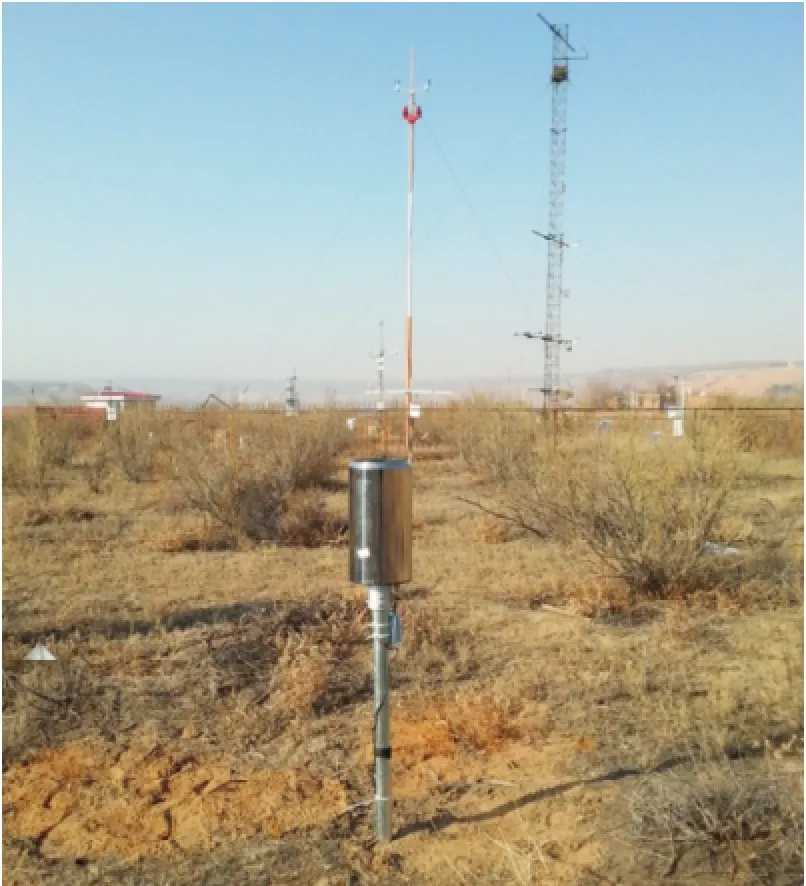
Figure 1 Photo of the automated tipping-bucket rain gauge at Water Balance Experimental Plot of Shapotou Desert Research and Experiment Station,Chinese Academy of Sciences
3 Results
Seasonal (from April to September) and annual statistics of daily rainfall and rainy days for measurements between 2008 and 2015 in relation to average long term (from 1956 to 2007) statistics are presented in Table 1.The differences in the ratio of mean seasonal to annual rainfall during the experimental period to the average long term statistics is 0.01 and 0.05 for mean rainy days (Table 1).This implies that the present short term experimental study is representative of long term statistics in this specific desert region.
The rainfall event number,duration,depth,intensity,and inter-event gap determined using a MIT of 0.5,1,2,3,6,12,and 24 h are presented in Figure 2.Varying depths of rainfall events from the same rainfall record were observed with the use of different MIT values,and rainfall events differed in duration and intensity,as well as the inter-event gap.Thus,MIT variation resulted in considerable variation in rainfall event parameters.For instance,MIT=30 min resulted in the identification of 0.50 mm rainfall depth,but this increased by 362% to 2.31 mm for MIT=24 h.Correspondingly,a much larger proportion of the total recorded length was included within defined rainfall events using a 30 min MIT,compared with a 24 h MIT.A longer MIT also generated events with larger event duration but reduced mean event rainfall intensity.The geometric mean event duration rose from 0.55 h for MIT=30 min to 4.40 h for MIT=24 h,an increase of greater than 8 times.
In terms of the inter-event gap,there were similarly clear variations relating to the choice of MIT.For MIT=30 min,the mean inter-event gap was 6.9 h (12.5 times longer than the mean event length),but this rose 15.9 times to 109.5 h (nearly 4.6 days or about 25 times the mean event duration) for MIT=24 h.The shortest inter-event gap was identical for a 30 min MIT.However,the inter-event gap retained a constant value of around 100 min for a MIT of 12 and 24 h.In all cases,the longest inter-event gap was a rainless interval of nearly 18.8 days.Long periods with no rainfall are expected in this arid region (Wang et al.,2001).
Mean event rainfall intensities were low,varying from 0.95 mm/h (MIT=30 min) to 0.53 mm/h (MIT=24 h).This represents a decline of about 44% as MIT increases based on the range tested.Maximum mean event rainfall intensities in the 8-year record fell from 21.5 mm/h for MIT=30 min to 4.7 mm/h for MIT=24 h,which represents a decline of 78%.Using the rainfall intensity classification of Tokay and Short (1996),the mean event lies in the 'light' category at MIT=30 min but shifts to the 'very light' category for MIT=24 h.The maximum event rainfall intensities fell into the 'moderate' category.

Table 1 Seasonal (from April to September) and annual statistics of daily rainfall and rainy days for measurements between 2008 and 2015 in relation to average long term (from 1956 to 2007) statistics
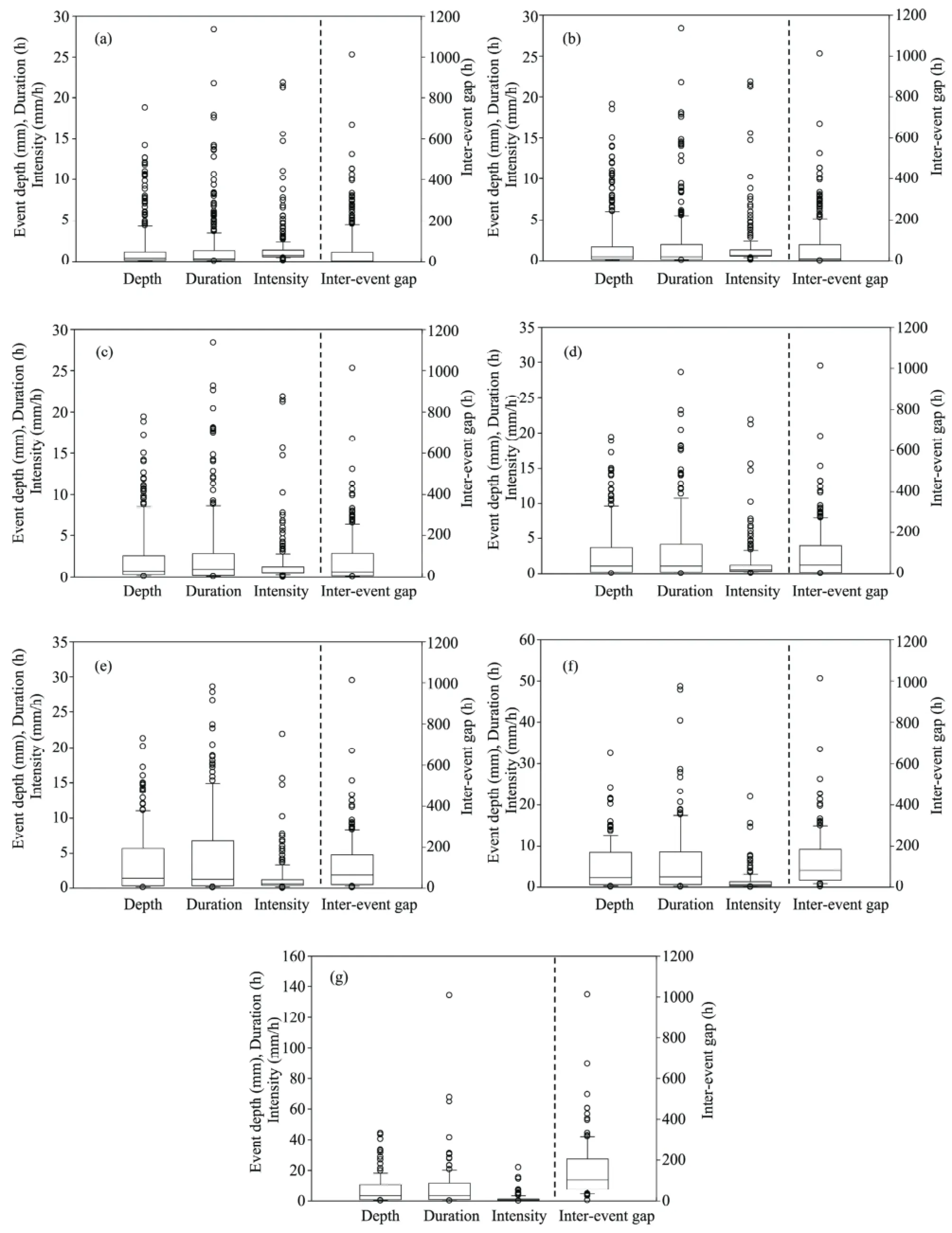
Figure 2 Distributions of rainfall event properties for eight years (2008-2015) identified by using a MIT of 0.5 h (a),1 h (b),2 h (c),3 h (d),6 h (e),12 h (f),and 24 h (g).Positive skewing with unbalanced patterns of outliers is evident.Note that the scale on the right hand axis applies to the inter-event gap length only
Highest mean event rainfall intensities were associated with short events.For an MIT of 30 min,the highest event rainfall intensity (21.5 mm/h) was for an event lasting 50 min.For an MIT of 24 h,the highest event rainfall intensity (4.7 mm/h) was for an event of 230 min.Within the rain gauge records,therefore,quite short events duration but having relatively high rainfall intensities recorded much longer dry intervals.
Relationships among rainfall parameters,viz,the event number,duration,depth,intensity,inter-event gap and MIT at the criteria of event rainfall depth varied from 0.1,0.5,1.0 and 5.0 mm are presented in Figure 3.All geometric mean rainfall event parameters correlated significantly with the MIT value with which they were identified.For a rainfall depth criterion > 0.1 mm (Table 2),the relationship established in the analysis of the 8 years rain gauge records with varying MIT ranging from 30 min to 24 h is as follows:
Number of rainfall events:

Event duration (h):

Event depth (mm):

Event rainfall intensity (mm/h):

Inter-event time (h):

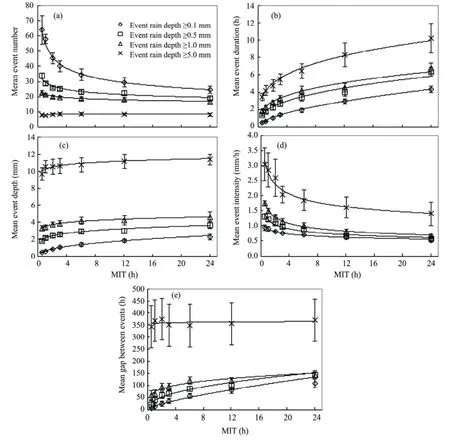
Figure 3 Relationships among the rainfall event number (a),duration (b),depth (c),intensity (d),inter-event gap (e) and MIT at a criteria of event rainfall depth varies from 0.1,0.5,1.0,and 5.0 mm

Table 2 Rain event properties and intra-event variability (mean and standard deviations in parentheses) for MIT varied in the range of 0.5 to 24 hours
The probability distribution of rainfall characteristics such as the percentage of rainfall occurrence in terms of varied duration,depth and rainfall intensity under different MIT of 3 h and 6 h are presented in Figures 4-6.The occurrence of an average rainfall duration less than five hours for an MIT=3 h accounted for 77.7% of the total probability,whereas it accounted for 63.7% for an MIT=6 h.The duration of less than five hours for an MIT=3 h is 22.0% greater than that of MIT=6 h.91.6% of rainfall events persist for less than 9 h if we set the MIT=3 h,and the corresponding value for an MIT=6 h is 13 h.The rainfall duration will increase with the prolonged interval rainless time (Figure 4).
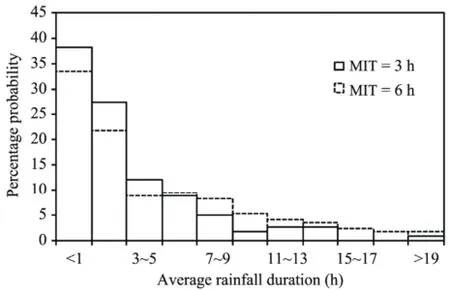
Figure 4 Percentage probability of rainfall duration with an MIT of 3 h and 6 h,respectively
There are notable differences in event rainfall depth of less than 1 mm and larger than 10 mm between MIT=3 h and MIT=6 h.Rainfall events with a mean depth of less than 1 mm have a higher occurrence probability (e.g.,51.1%) for MIT=3 h than that of MIT=6 h (e.g.,43.7%),whereas this trend is reversed when the mean depth is greater than 10 mm (Figure 5).
There are remarkable differences in the occurrence probability of mean rainfall intensity when it is less than 1 mm/h for MIT=3 h and MIT=6 h.For MIT=6 h,rainfall intensity of less than 0.5 mm/h will reach 33.7% of the total distribution,and with an intensity of less than 2 mm/h it is 89.2% while for MIT=3 h,84.7% of rainfall intensity falls into the range of less than 2 mm/h.Generally,the rainfall event with intensities of less than 1.0 mm/h constitute the major rainfall events (around 64.5% of the total rainfall events) either at MIT=3 h or MIT=6 h,though the trend is reversed in two scenarios as presented in Figure 6.
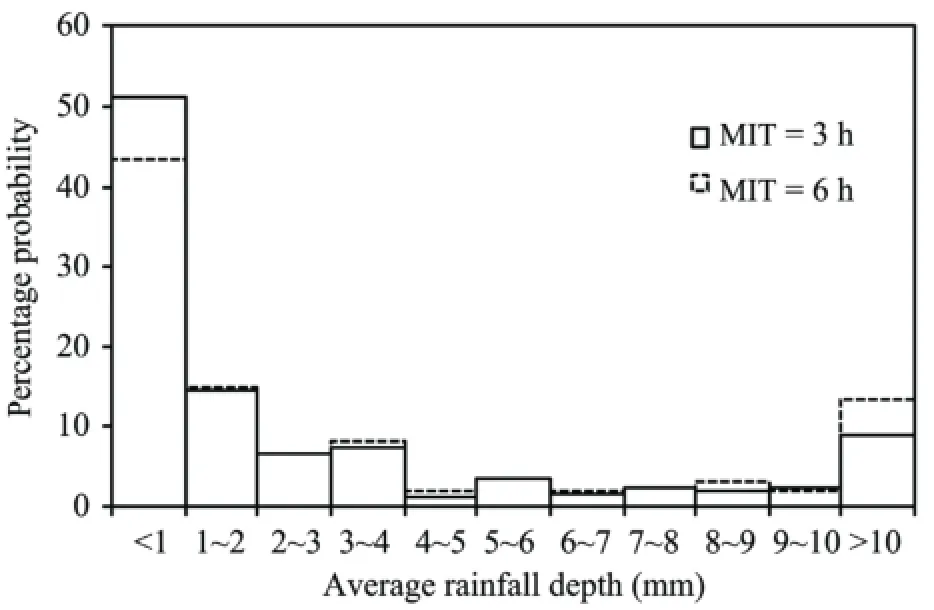
Figure 5 Percentage probability of rainfall depth with an MIT of 3 h and 6 h,respectively
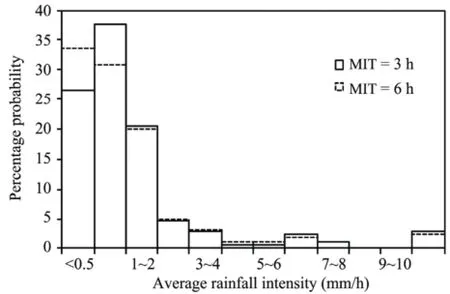
Figure 6 Percentage probability of rainfall intensity with an MIT of 3 h and 6 h,respectively
4 Discussions
Provided that the occurrence and magnitude of annual rainfall was distributed equally,there will be a0.5 mm depth daily rainfall (the average annual precipitation is 188 mm based on long term observations from 1955 to 2011).This means that it is of no significance to desert ecosystems if the rainfall is equally distributed.The reality is that the extreme temporal variability of hydrological processes resulting in a few rainfall events per year only,contributes to the major part of the annual water balance which ultimately controls the most basic ecologic patterns and processes.The aggregation of rainfall events increases its availability and significance to the water-limited desert ecosystems.
Rainfall features,such as event numbers,mean intensity,and geometric mean event duration,are dependent on the minimum inter-event time (Figures 2,3).Therefore,the selection of an MIT criterion involves a compromise between the independence of widely-spaced events and their increasingly variable intra-event characteristics.The variation of rainfall features in terms of the criteria selection of 0.1,0.5,1.0,and 5.0 mm (Figure 3) goes along with the hydrological processes of plant canopy water redistribution and soil infiltration processes.For example,if the criteria value for stemflow generation is 1.0 mm for certain desert shrubs (Zhang et al.,2015),a 1.0 mm rainfall depth is suitable in determining the events number and calculating total stemflow throughout the growing season.Meanwhile,a 0.5 mm rainfall depth is required for throughfall generation (Zhang et al.,2015),and 5.0 mm rainfall depth is considered as effective rainfall to replenish the soil moisture in bare dunes (Chen,1988).Given the importance of rainfall event properties,it is required that the identification protocols employed in data reduction should be reported in all cases (Dunkerley,2008).
By comparing the percentage probability of rainfall features with MIT=3 h and 6 h (Figures 4-6),the difference in MIT has a significant influence on rainfall duration than that of depth and intensity.Considering the range of variation in rainfall depth and intensity with varied MIT as mentioned above (Figures 5 and 6),and the limitation imposed by very low values (less than 1 mm in depth,Figure 5,and less than 1 mm/h in intensity,Figure 6),adopting a more applicable MIT of 6 h in the present study area would be more reliable.This approach depends on whether taking into account the influence of canopy water storage capacity on rain water redistribution (Wang et al.,2012),or the effects of antecedent soil moisture content on infiltration processes (Li et al.,2004) and surface runoff generation (Wheater et al.,1982).
On average,there will be 35 individual rainfall events lasting for two hours with a depth of 1.4 mm,and intensity of 0.7 mm/h during the period from April to September at MIT=6 h.The values of rainfall depth and intensity characterized for such rainfall events in line with previous studies such that the sustainability of the revegetated desert ecosystem in Shapotou area mainly relies on the properties of individual rainfall events (Chen,1988; Zhao,1988; Wang et al.,2008).In contrast,the inconsistencies of the catchment soil water balance and daily rainfall input within the water-limited desert ecosystems resulted from the identification of individual rainfall events,affecting the precipitation redistribution processes through the interaction between rainfall,vegetation and soil.Ecosystems respond to rainfall and other driving variables at different temporal scales,which may complicate our understanding of the relationships that govern ecosystem conditions.Characterizing the event-based rainfall properties will be more important in clarifying the driving factors of the arid ecosystems succession.In desert areas where rainfall is the sole water resource through soil moisture,such as in Shapotou area,vegetation size,structure and ecosystem patterns is the consequence of water availability and the cause of water redistribution dynamics of desert plants.
The applications of the effects of variation in rainfall patterns on ecosystem productivity have been widely reported.A study on above-ground net primary productivity response to increasing rainfall event size indicates that plots of semi-arid grassland receiving fewer,but larger rain events had the highest rates of above-ground net primary productivity,compared to plots receiving more frequent rainfall (Heisler-White et al.,2008).Soil moisture data indicated that larger events led to greater soil water content and likely permitted deeper moisture penetration in the soil profile (Li et al.,2004).Even if total rainfall inputs for a given system remained unchanged,predicted changes in the distribution of rainfall events will impact the timing and quantity of soil water available for plant uptake and biogeochemical processes (Weltzin et al.,2003).These results indicate that arid and semi-arid ecosystems are capable of responding immediately and substantially to forecast shifts to more extreme rainfall patterns,compared with the short grass steppe ecosystem in northeastern Colorado,USA,where rainfall patterns characterized by large events with long intervening dry intervals could be particularly important in semi-arid grasslands; this observation is attributable to the marked contrast in frequent but small events that have historically defined this short grass steppe ecosystem (Heisler-White et al.,2008).From the viewpoint of management implications on arid and semi-arid ecological restoration in ecologically vulnerable regions,the present study indicates that besides a consideration of the average annual precipitation on the sustainability of the revegetated desert ecosystem,rainfall events characteristics plays a very important role in regulating the ecosystem structure and processes more generally.Accordingly,the non-linear relationships inherent in ecosystem interactions during the growing season need to be fully understood in future research in order to provide a better assessment of the role of rainfall variance on restored desert shrub land functioning and heterogeneity.
Acknowledgments:
This work was funded by the National Natural Science Foundation of China (Grant Nos.41530750,41501108 and 41371101).The authors are indebted to two anonymous reviewers for their helpful and constructive comments and suggestions for improving the manuscript.We are very grateful to Professor B.Ubi for his careful reading and correcting of the manuscript.
References:
Chen WR,1988.Water balance in the revegetated area along the railway in Shapotou area.Research on Controlling the Shifting Desert (2).Yinchuan:Ningxia People's Press,pp.66-75.(in Chinese)
Dunkerley D,2008.Identifying individual rain events from pluviograph records:a review with analysis of data from an Australian dryland site.Hydrological Processes,22(22):5024-5036.DOI:10.1002/hyp.7122.
Hamilton EL,Rowe PB,1949.Rainfall Interception by Chaparral in California.Division of Forestry,Department of Natural Resources.Sacramento,State of California,USA,pp.43.
Heisler-White JL,Knapp AK,Kelly EF,2008.Increasing precipitation event size increases aboveground net primary productivity in a semi-arid grassland.Oecologia,158(1):129-140.DOI:10.1007/s00442-008-1116-9.
Karl TR,Trenberth KE,2003.Modern global climate change.Science,302:1719-1723.DOI:10.1126/science.1090228.
Li T,Xiao HL,Li XR,2001.Modeling the effects of crust on rain infiltration in vegetated sand dunes in arid desert.Arid Land Research and Management,15(1):41-48.DOI:10.1080/15324980119192.
Li XR,Ma FY,Xiao HL,et al.,2004.Long-term effects of revegetation on soil water content of sand dunes in arid region of Northern China.Journal of Arid Environments,57(1):1-16.DOI:10.1016/S0140-1963(03)00089-2.
Mc Auliffe JR,2003.The atmosphere-biosphere interface:the importance of soils in arid and semi-arid environments.In:Weltzin JF,Mc Pherson GR (eds.).Changing Precipitation Regimes and Terrestrial Ecosystems:A North American Perspective.Tucson:University of Arizona Press,pp.9-27.
Noy-Meir I,1973.Desert ecosystems:environment and producers.Annual Review of Ecology and Systematics,4(1):25-51.DOI:10.1146/annurev.es.04.110173.000325.
Restrepo-Posada PJ,Eagleson PS,1982.Identification of independent rainstorms.Journal of Hydrology,55(1-4):303-319.DOI:10.1016/0022-1694(82)90136-6.
Tokay A,Short DA,1996.Evidence from tropical raindrop spectra of the origin of rain from stratiform versus convective clouds.Journal of Applied Meteorology,35(3):355-371.DOI:10.1175/1520-0450(1996)035<0355:EFTRSO>2.0.CO;2.
Wang XP,Cui Y,Pan YX,et al.,2008.Effects of rainfall characteristics on infiltration and redistribution patterns in revegetation-stabilized desert ecosystems.Journal of Hydrology,358(1-2):134-143.DOI:10.1016/j.jhydrol.2008.06.002.
Wang XP,Li XR,Zhang JG,et al.,2005.Measurement of rainfall interception by xerophytic shrubs in re-vegetated sand dunes.Hydrological Sciences Journal,50(5):897-910.DOI:10.1623/hysj.2005.50.5.897.
Wang XP,Wang ZN,Berndtsson R,et al.,2011.Desert shrub stemflow and its significance in soil moisture replenishment.Hydrology and Earth System Sciences,15(2):561-567.DOI:10.5194/hess-15-561-2011.
Wang XP,Zhang JG,Li XR,et al.,2001.Distribution,trends and variability in precipitation in Shapotou region.Journal of Desert Research,21(3):260-264.DOI:10002694X(2001) 0320260205.(in Chinese)
Wang XP,Zhang YF,Hu R,et al.,2012.Canopy storage capacity of xerophytic shrubs in Northwestern China.Journal of Hydrology,454-455(3):152-159.DOI:10.1016/j.jhydrol.2012.06.003.
Weltzin JF,Loik ME,Schwinning S,et al.,2003.Assessing the response of terrestrial ecosystems to potential changes in precipitation.BioScience,53(10):941-952.DOI:10.1641/0006-3568(2003)053[0941:ATROTE]2.0.CO;2.
Wheater HS,Shaw TL,Rutherford JC,1982.Storm runoff from small lowland catchments in southwest England.Journal of Hydrology,55(1-4):321-337.DOI:10.1016/0022-1694(82)90137-8.
Xiao HL,Cheng GD,Li XR,et al.,2004.Ecohydrological change mechanism of a rainfed revegetation ecosystem at southeastern edge of Tengger desert,Northwest China.Science in China (D),47(Supp.1):71-77.DOI:10.1360/04zd0008.
Zhang YF,Wang XP,Hu R,et al.,2015.Rainfall partitioning into throughfall,stemflow and interception loss by two xerophytic shrubs within a rain-fed re-vegetated desert ecosystem,northwestern China.Journal of Hydrology,527:1084-1095.DOI:10.1016/j.jhydrol.2015.05.060.
Zhao XL,1988.Problems of revegetation on sand dunes in Shapotou area.Research on Controlling the Shifting Desert (2).Yinchuan:Ninxia People's Press,pp.27-57.(in Chinese)
Wang XP,Zhang YF,Hu R,et al.,2016.Revisit of event-based rainfall characteristics at Shapotou area in northern China.Sciences in Cold and Arid Regions,8(6):0477-0484.
10.3724/SP.J.1226.2016.00477.
*Correspondence to:XinPing Wang,Professor of Northwest Institute of Eco-Environment and Resources,Chinese Academy of Sciences.No.320,West Donggang Road,Lanzhou,Gansu 730000,China.E-mail:xpwang@lzb.ac.cn
May 30,2016Accepted:July 22,2016
杂志排行
Sciences in Cold and Arid Regions的其它文章
- Interdecadal correlation of solar activity with Tibetan Plateau snow depth and winter atmospheric circulation in East Asia
- Relationship between sand-dust weather and water dynamics of desert areas in the middle reaches of Heihe River
- Quantitative retrieval of soil salt content based on measured spectral data
- Comparison of soil physico-chemical properties under different land-use and cover types in northeasternChina's Horqin Sandy Land
- Comparison analysis of sampling methods to estimate regionalprecipitation based on the Kriging interpolation methods:A case of northwestern China
- Discussion on applying an analytical method to optimize the anti-freeze design parameters for underground water pipelines in seasonally frozen areas
